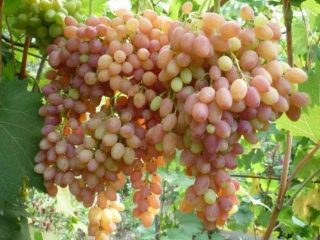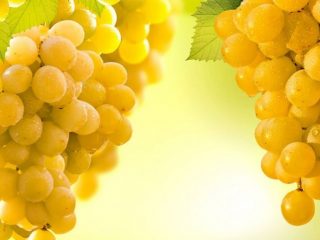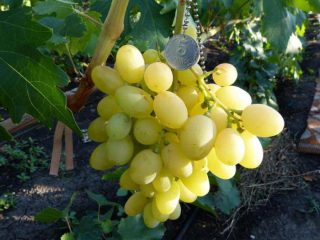Content
Gardeners love to grow early varieties of crops. When the main varieties on the site are still preparing for fruiting, the early ones are already delighting the owners with their harvest. Therefore, “Russian Early” grapes can very often be found in the garden, even among inexperienced gardeners. This is a hybrid variety, obtained by crossing two forms - “Shasla Northern” and “Michurinets”.
A description of the characteristics and properties of the “Russian Early” grapes was compiled at the Institute of Viticulture and Winemaking named after. Ya. I. Potapenko of the city of Novocherkassk. The hybrid is a very early fruiting table variety that can withstand low temperatures. Thanks to these qualities, it is grown in all regions of Russia, even in the Urals and Siberia. Table grape varieties are characterized by excellent taste and are intended for fresh consumption. “Russian Early” fully justifies its purpose. To ensure that the description of the “Russian Early” grape variety is as detailed as possible, the article will use photos, videos and reviews from gardeners.
Description of the variety
First, let's look at the characteristics due to which winegrowers choose this hybrid for planting.
Of course it is harvest ripening period. Already in July, raspberry-red berries flaunt on the bushes of the “Russian Early” grape variety. At this time, the first signs of fruit ripening are just appearing on the bushes of other varieties.With proper care, the variety will delight you with ripe grapes at the end of June. To accurately determine the time of harvest in your region, count 110-115 days from the moment the buds open. Early grapes begin to bear fruit 2-3 years after planting, subject to proper cultivation practices.
Productivity. One fruitful shoot forms 2-3 inflorescences. Each adult bush ripens up to 25 kg of delicious berries. Young plants produce about 7 kg per bush.
Bush medium-sized, but grows quite widely. A mature vineyard occupies a plot up to 5 meters wide. The early grape variety has a special feature.
Attention! A layer of perennial wood does not immediately form on the vine. It is this characteristic that leads to poor yields in the first 3-4 years of the bush’s life.
Therefore, gardeners need to annually do medium and short pruning in places where the thickness of the growth is 20-25 cm. This feature is noted in the description of the Russian Early grape variety.
Leaves round or heart-shaped, with slight pubescence on the lower plate, are found on the plant. They are located on long petioles and hold tightly.
Bunches loose, not very large. In order for the plant to form a large cluster, winegrowers leave no more than 2 inflorescences on one stem. If you leave more, the ripening process will be delayed and the clusters will be small.
The special value of the “Russian Early” grapes is berries (see photo).
They are medium in size but very tasty. The taste of the fruit is sweet with a slight sourness. Aroma Contains notes of caramel scent. Gardeners gave the early grape variety a second name - “Caramel”. The grapes are oval in shape and weigh up to 6-7 g.The pulp is slightly crunchy and accumulates sugar content well. If there is a lack of moisture, they may begin to crack and attract insects. The fruits are firmly attached to the stalk, so the variety tolerates transportation well and the berries remain on the bush for a long time. This makes it possible not to harvest the entire crop at once.
A short video about the grape variety without comments:
Frost resistance early hybrid is very good. Up to -23⁰С the variety does not require shelter. This characteristic, combined with early fruiting, allows the Early Russian grapes to be grown in areas with short summers and cold winters.
Resistance to many diseases the culture is very good. It is very important that the variety is not affected by mildew and oidium, and is also not susceptible to rotting. It also resists tick attacks well. But “Early Russian” has no immunity against phylloxera. Therefore, without the use of pest control measures, the yield will begin to decline, and after 6-8 years the bush will die.
The early variety is used for the production of wines and juices, but not often. It is mainly in great demand among buyers for fresh consumption.
Advantages and disadvantages
According to gardeners, the “Russian Early” grape variety has many advantages that have led to its well-deserved popularity:
- very early fruiting;
- sufficient yield;
- unusual and pleasant taste;
- frost resistance;
- transportability;
- resistance to major grape diseases;
- preservation of the brushes on the bush without loss of taste;
- ease of care;
- good cuttings.
Among the disadvantages, winegrowers note:
- not very large berry size;
- low yield during the growing period of the bush;
- berries are prone to cracking due to irregular watering and prolonged rains;
- susceptibility to attacks by wasps and bees.
Despite the disadvantages of the early variety, winegrowers love it very much and are happy to share their growing experience.
Choosing a place and landing
Although the variety is considered unpretentious, sufficient attention should be paid to the choice of location and planting. The further development of the plant depends on how well these measures are carried out. The technology for planting the variety is standard, but there are some recommendations:
- It is better to plant seedlings on the south side of country buildings. This is how experienced gardeners advise placing “Russian Early” grapes in their reviews. They explain this by the fact that at night the building gives off the heat accumulated during the day to the plants.
- The variety is planted in autumn and spring, but it is preferable to do this at the end of the season. In this case, the seedlings adapt more easily and fully develop in the spring. Spring planting is carried out only with seedlings with buds in a dormant state.
- The hybrid is well planted in an arbor planting.
Descriptions and photos of the stages of the process help novice gardeners to properly plant Russian Early grapes.
For the vineyard, choose a sunny place with protection from the winds. They mark the place and dig holes. Hybrid bushes grow strongly, so the distance between two seedlings should be at least 3 meters. Each bush requires an area of 5-6 square meters. m. These values must be taken into account when marking. Holes for bushes are made at least 50 cm deep. If planting occurs in the fall, then the holes are prepared in 2 weeks; in the spring, the period can be reduced to 3-4 days. A drainage layer is placed on the bottom, then a mixture of humus and fertile soil (1:2), as well as sand (0.5 buckets).The soil is watered, and when it settles a little, earth and wood ash (0.5 kg) are added again. They leave a hole to allow the ground to settle, and then begin planting.
Be sure to pay attention to the condition of the grape seedlings. They must be free of damage and signs of pest or disease. The plants are placed in a hole, at the same time a pipe is dug in for watering, and the grape seedling is covered with soil. Then water it.
Grape care
An important point in caring for bushes is watering. When growing the “Early Russian” variety, you will need to perform vegetative and moisture-recharging irrigation. Moisture charging is carried out in autumn and spring, the first is more important for grapes. The autumn event increases the frost resistance of the bush. The timing of watering depends on weather conditions. In summer, two full waterings are enough for the variety. The first time is after flowering, the second time is when the berries begin to ripen. Water consumption per plant is 10-20 liters.
Despite the fact that in the description the “Russian Early” grape variety is called unpretentious, it will not be easy to get a harvest like in the photo without fertilizing. Nutrition is added throughout the growing season. In spring, grape bushes need a full range of nutrients. Winegrowers use mineral complex fertilizers. When the time comes for the fruit to ripen, potassium and phosphorus are added. Before covering the bushes for the winter, repeat feeding with a complex mineral composition. Organic matter needs to be added no more than once every 2-3 years and in the fall. Fertilizing grapes is combined with watering so as not to harm the roots.
Another important point of care for the Early Russian variety is pruning and shaping the bush.
The variety is pruned annually.The yield and presentation of grapes depends on the regularity and quality of pruning. It is important to prune the “Russian Early” grapes on time. Too early - leads to loss of juice during grape weeping, late leads to uneven development of the bush. Therefore, it is recommended to start during a period when constant heat has established. Experienced winegrowers know special signs on the vine that indicate the beginning of pruning.
Young gardeners need to adhere to some rules when growing varieties:
- During the first 2 years of the bush’s life, only dry parts are removed.
- The real pruning is done after the vine has lignified.
- Young shoots are not pruned while the trunk is small. Gardeners wait until it grows, and then they start trimming the skeleton.
- When pruning grapes, do not forget about normalizing the load. No more than 2-3 brushes are left on one shoot.
Another topic that worries gardeners is pest protection. The variety is affected by phylloxera and is very attractive to wasps. The fight against phylloxera must begin from the moment of planting. For this, the soil is properly prepared. If the site has sandy soil, then this is very good. In another case, sand is added to the pits.
As soon as infected bushes are noticed, they are destroyed. Grape leaves on which the pest is noticed are torn off and burned. For treatment, the drugs Fozalon, Actellik, and Fastak are used.
Wasps become a nuisance late in the season when crops are ready to be harvested.
You need to fight them in the usual ways - destroy nests, burn smoke bombs, lay out bait.Special bags or mesh with small holes that protect the grapes save you from birds.
Reviews
Video review from the gardener:
















